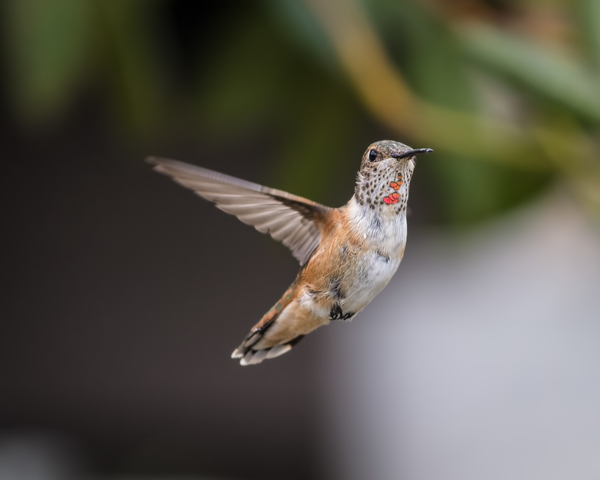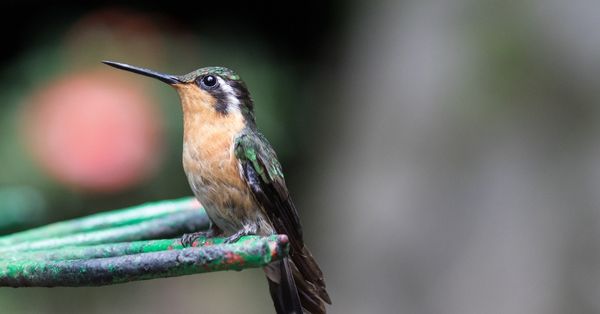South Carolina is home to a diverse array of hummingbirds, each with its own unique characteristics and behaviors.
In this article, we will explore the 8 types of hummingbirds found in South Carolina, including their physical traits, habitats, and feeding habits.
Whether you’re a seasoned birdwatcher or simply curious about the wildlife in your area, this guide will provide an informative introduction to the hummingbirds of South Carolina.
| Image | Name |
|---|---|
 | Ruby-Throated Hummingbird |
 | Rufous Hummingbird |
 | Anna's Hummingbird |
 | Allen Hummingbirds |
 | Black-chinned Hummingbirds |
 | Calliope hummingbirds |
 | Broad-Billed Hummingbird |
 | Buff-bellied Hummingbird |
Types of Hummingbirds in South Carolina (SC)
1. Ruby-Throated Hummingbird

The upper parts of a Ruby-throated Hummingbird are light green, while the lower parts are light gray.
There is a notch in the tail of females and young birds and a fork in the tail of adult males.
Although females and juveniles possess a white, unremarkable neck, males of this species are named for their stunning ruby color.
In much of eastern North America, ruby-throated hummingbirds may be seen in the vicinity of stream banks, meadows, coniferous trees, old farms, gardens, and orchards.
Mostly in the summertime, when it is breeding season, the ruby-throated hummingbird may often be seen congregating at bird feeders and more conventional bird baths in search of nectar.
But keep in mind that during the actual mating season, Ruby-throats may be rather violent, defending their territory from many other males and sometimes even bigger birds.
They rely on the nectar of tubular flowers, including scarlet beebalm and native honeysuckles, which bloom in shades of vivid red, pink, and orange.
Small insects provide an addition to this diet.
You can count on them to show up at their summertime nesting sites somewhere between the months of April and May, and you can see them make the long, magnificent voyage south to their wintering sites across the south and central America by the end of October.
The Rufous hummingbird represents the only migratory hummingbird species that winters throughout South Carolina.
There are much fewer reports of Rufous birds than of Ruby-throated Hummingbirds.
2. Rufous Hummingbird

The males of the species of hummingbird known as a rufous hummingbird are so called because of the bright orange color of their throats.
In addition, males have white shoulders and chests, greenish accents, and bright orange coloring on their backsides and abdomen.
Their tails tip inward when stretched.
Females and juveniles of the Rufous hummingbird have the male pattern of streaks and spots, but their coloring is less rufous overall.
The only places you’ll find any rufous coloring are on their flanks and in little spots on their tails; their backs, wings, and heads are all a dull green.
Feeding territories of rufous hummingbirds may be found across stream banks, woodland fringes, and alpine meadows.
Western and Northwestern mating birds are just as likely to choose a spot on the edge of a clearing as a patch of brushy second growth.
In late July or early August, they depart the eastern United States for their winter habitats across southern California, Arizona, and Mexico, where there are many wildflowers.
This journey takes them overland via the Rocky Mountains.
For sustenance, they mostly consume nectar from early spring flowers, in addition to occasional insects and tiny spiders.
They will also sip sugar syrup nectar prepared at home or sap from cavities created by sapsuckers.
The rufous hummingbird is well-known for its ferocity while protecting its nectar territory from other birds or mammals, especially those that are bigger.
The following species of hummingbirds are rare throughout South Carolina and might only be observed once or twice in recent history.
Across North America, they may be seen for short periods along the overland path of their migratory map.
In addition, these birds are frequently juveniles, making identification much more challenging.
Actually, sphinx moths are often misidentified as hummers.
3. Anna’s Hummingbird

Metallic green best describes the appearance of Anna’s hummingbird; males have had more noticeable, dark greenish backs than females or juvenile birds, which are more subdued and have grey undersides.
Females might have had a spotted pattern on their necks with traces of pink, whereas males possess silvery rose-pink necks and crowns.
You may see Anna’s hummingbirds all along the coast of the Pacific Ocean, from northern Mexico and southern Texas to southern Alaska.
One among the four hummingbird species found in the mid-Atlantic region of the United States and Canada.
In addition, Anna’s hummers don’t engage in the regular hummingbird migration, rather settling down in colder regions for the wintertime.
They spend the warm months at higher elevations, but when winter comes, they go toward lower ground.
Since their real ranges are so large and diverse, they may be spotted in a wide variety of environments, from stream banks and chaparral to open forests and coastal sage scrub, as well as in parks and gardens.
Their diet is the same as that of other hummingbirds, consisting mostly of insects and nectar.
Anna’s hummers are among of the loudest of the hummingbird species, and their warmer months mating areas are sometimes inundated with the males’ buzzing choruses.
As a result of their fierce guardianship of the mating areas, they may engage in dramatic fly displays at some other birds and even humans.
4. Allen Hummingbird

Allen’s hummingbirds are a light copper hue and resemble Rufous hummingbirds; however, they have distinctive greenbacks that the Rufous hummingbird does not.
The males are distinguished by their coppery stomachs, greenbacks and tails, and vivid reddish-orange throats.
Chaparral, wide oak woodland, coastal woods, meadows, and parkland are just some places where you could see Allen’s hummingbird.
This hummingbird of Mexico and the arid southwestern United States often overwinter in Mexico.
However, many stay across California year-round or move to the eastern US for the wintertime because of climate change, weather-related circumstances, and other environmental variables.
This may account for certain hummingbird sighting in eastern states during the winter.
Allen’s hummingbirds mostly feed on nectar but may eat small insects.
5. Black-chinned Hummingbird

Unlike males, females and juveniles of the black-chinned hummingbird have a drab grayish-to-white underside to contrast with their bright green upper bodies.
There is occasionally a faint spotting on their necks.
Male black-chinned hummingbirds are all green on top, including their heads and wings; their bellies are a lighter shade of green, and their chests are gray.
Black at the base of their necks, vivid purple runs the length of it.
Hummingbirds like the black-chinned kind may be found around water and in open areas such as parks and lawns, where they eat insects and nectar from tubular flowers.
Black-chinned hummingbirds may be seen soaring through the summer skies from British Columbia in the north to California and Texas in the south.
It’s not uncommon to see drifters in the Palmetto State.
6. Calliope Hummingbird

The little, hunched-back birds known as calliopes are hummingbirds.
Females and juveniles have a pale green upper body and a pinkish tint to their bellies.
Male Calliope hummingbirds are easily identifiable by their bright greenish gray green backs, chests, and striking magenta streaks of plumage around their necks.
Calliope hummingbirds nest at altitudes of 4,000 feet or higher, occupying habitats such as woodland clearings, canyons, and streamside areas.
It has recently been reported seeing them at an altitude of 11,000 feet.
They spend the summer across northern Mexico and southern Canada and then go south during the winter.
During the autumn and springtime humming migration months, these little birds travel about 5,600 miles, making them the tiniest long-distance migratory birds in the world.
Calliope hummingbirds get their nutrition from nectar and insects.
7. Broad-Billed Hummingbird

The backs of females and juveniles are yellowish-green, and there is also some yellowish-green on their heads.
The undersides of their wings, as well as their faces, are typically gray in color.
Behind each of their eyes, their features have a white band.
Males have a brilliant bluish-green color, and they have a blue neck and a dark grayish band over their distinctive bills, which are red, wide, and tipped with black.
Females are brownish-gray.
They are found largely in the central and northwest regions of Mexico.
However, their mating range does extend into the southern parts of the United States (particularly in New Mexico, southern Arizona, and Texas).
They make their homes in the deep gorges and ravines of the surrounding mountains.
During the mating season, the male will pursue the female with a precise flying show that observers often liken to the swinging pocket watch used by hypnotists.
8. Buff-bellied Hummingbird

This hummingbird is about the size of a cardinal and possesses a buff abdomen and shimmering olive-green top parts, with the females having less coloration than the males.
Their beak is rather narrow and red, having a darker apex than the rest of the beak.
Additionally, the males possess a shimmering golden-green coloration on the neck.
They like to raise their young among semiarid scrub, pine-oak woodlands, and streamside habitats, in addition to lawns, and they breed everywhere from southern Texas to the Yucatan peninsula in Mexico.
There are three different subspecies, but only one of them can be found in the U.S.
Conclusion
In conclusion, South Carolina is a wonderful place for bird enthusiasts, particularly those interested in observing the beautiful and graceful hummingbirds in their natural habitats.
With eight distinct types of hummingbirds found in the state, there is always something new to discover and admire.
From the vibrant Ruby-throated Hummingbird to the tiny and elusive Rufous Hummingbird, each species offers a unique glimpse into the fascinating world of these tiny birds.
Whether you’re a seasoned birder or just starting out, exploring the diverse hummingbirds of South Carolina is a rewarding and unforgettable experience.
So, get ready to be mesmerized by their vivid colors, energetic movements, and musical chirping as you observe them in their natural habitats.
FAQ
What is the most common type of hummingbird found in South Carolina?
The most common type of hummingbird found in South Carolina is the Ruby-throated Hummingbird. These birds are known for their brilliant green and red feathers and can be found throughout the state during their breeding season.
When do hummingbirds migrate through South Carolina?
Hummingbirds typically migrate through South Carolina in the spring and fall. During the spring migration, they are heading north to breed, while during the fall migration, they are heading south to their wintering grounds in Central and South America.
What is the smallest type of hummingbird found in South Carolina?
The smallest type of hummingbird found in South Carolina is the Calliope Hummingbird. These tiny birds weigh only about a tenth of an ounce and are about 3 inches long.
How can I attract hummingbirds to my backyard in South Carolina?
You can attract hummingbirds to your backyard in South Carolina by providing them with nectar feeders and planting native flowers that produce nectar, such as trumpet creeper, cardinal flower, and bee balm.
What is the lifespan of a hummingbird?
The lifespan of a hummingbird varies depending on the species, but most live for an average of 3-5 years.
Last Updated on April 6, 2023 by Lily Aldrin
